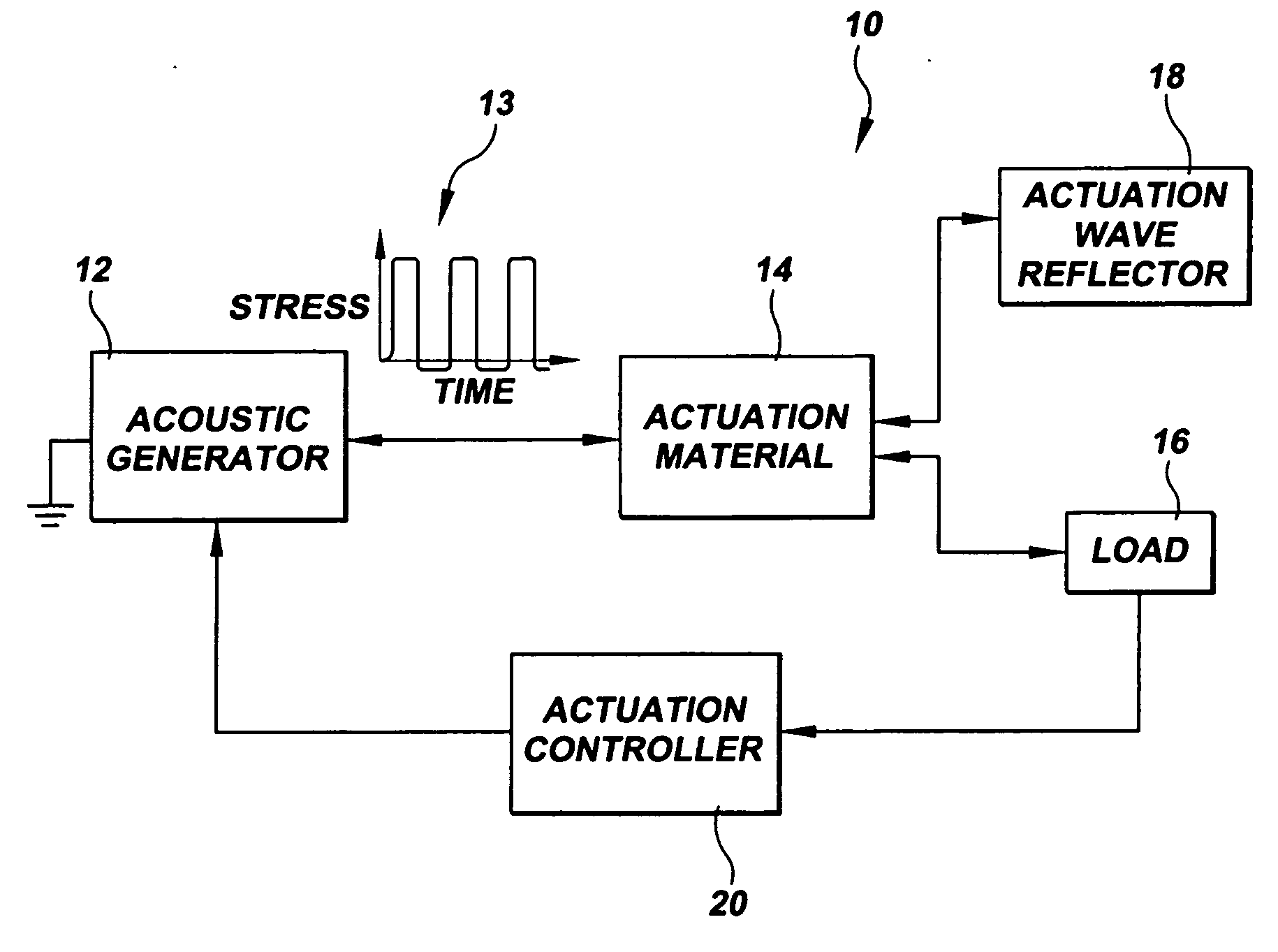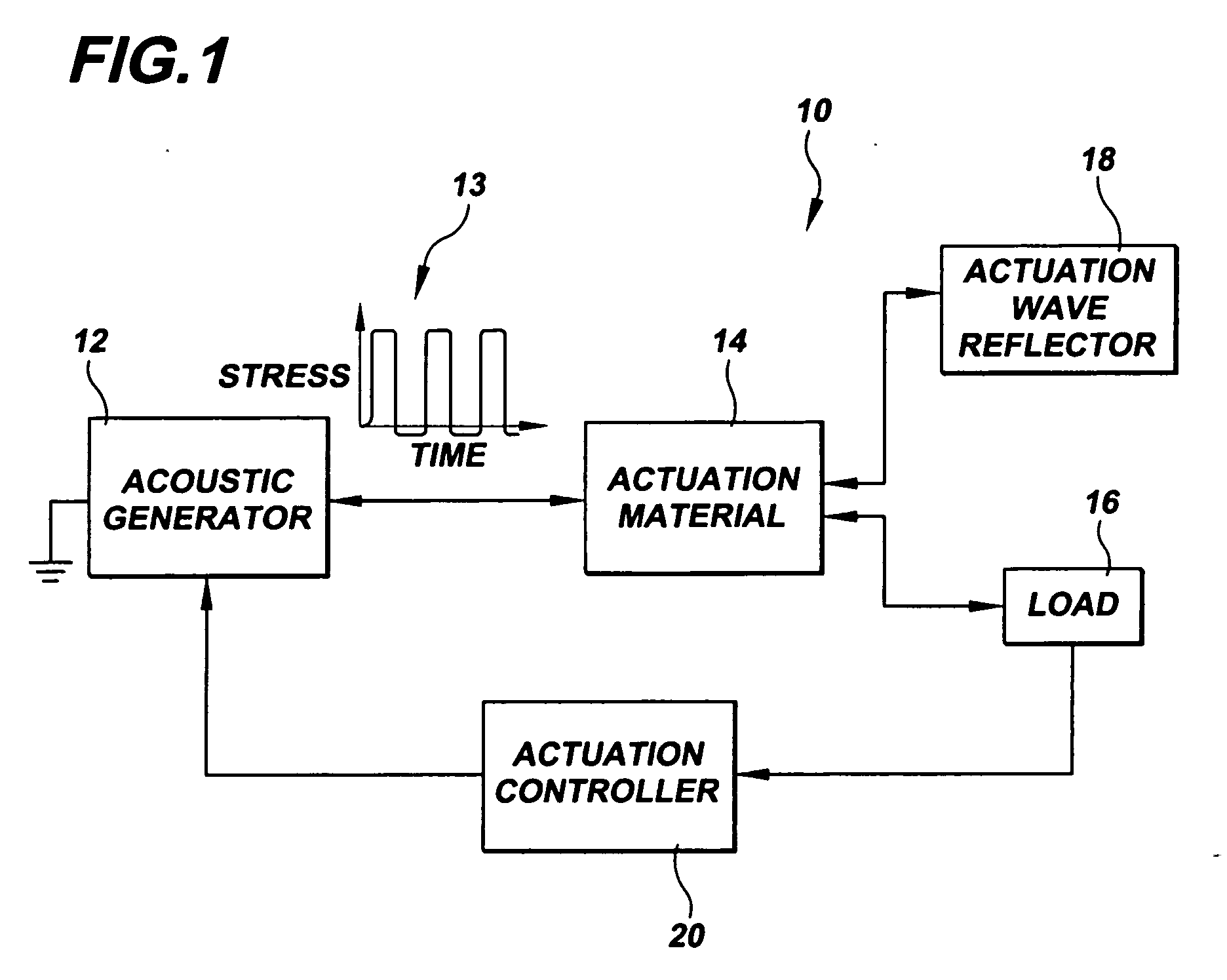Acoustic pulse actuator
a pulse actuator and pulse technology, applied in the field of actuators, can solve the problems of general limitation of piezoelectric actuators, fundamental limitation of electrical conductivity of magnetostrictive materials, and limitations in actuation capabilities, and achieve the effects of large actuation stroke, high output strain, and fast actuation response tim
- Summary
- Abstract
- Description
- Claims
- Application Information
AI Technical Summary
Benefits of technology
Problems solved by technology
Method used
Image
Examples
example 1
[0095] An acoustic actuator in accordance with the invention was built for experimental analysis of the actuator performance. A schematic view of the experimental actuator 100 is shown in FIG. 6. The actuation material was provided as a single crystal FSMA 110, specifically, a single crystal of tetragonal Ni—Mn—Ga measuring 6.58 mm in a longitudinal actuation direction, with a cross section of 2.35 mm×3.87 mm. The crystal was heat treated and cooled under stress, in the manner described above, to obtain a single twin variant structure prior to actuation.
[0096] The acoustic generator was provided as a piezoelectric stack 112, specifically, a Piezo Systems T18-H5-104 piezoelectric stack actuator, which is capable of producing about 14 μm of displacement at an input actuation voltage of about 100 V. A clamp 114 was employed to hold the stack in place and position the stack relative to the other acoustic actuator elements, without the use of a bonding agent. The clamp was also employed...
example 2
[0102] The acoustic actuator of Example 1 was configured for bidirectional actuation without a load to produce both extensional stroke as well as compression under a no-load condition. To achieve this operation, the pre-stress applied by the piezoelectric stack clamp 114 was increased and the rise time of the input control voltage pulse was decreased. The input control voltage magnitude for controlling the piezoelectric stack was 100 V and the pulse repetition rate was set at 100 Hz. FIG. 9 is a plot of the resulting strain measured in the FSMA actuation material. The extensional actuation was slightly less effective than the compressive actuation. This is evident in FIG. 9, where the time required to extend the FSMA crystal (increasing strain) is somewhat longer than the time required to compress the crystal (decreasing strain). This asymmetry in response time may be due to insufficient piezoelectric stack pre-stress.
example 3
[0103] The acoustic actuator of Example 1 was configured for bidirectional actuation without a load and for a range of piezoelectric stack control voltage pulses. The acoustic actuator was operated for 1.9 s, corresponding to 190 piezoelectric stack displacements and corresponding acoustic stress waves, for each selected voltage. The input voltage was varied linearly between 20 V and 100 V. The pulse repetition rate was 100 Hz. FIG. 10 is a plot of the maximum absolute strain generated in the FSMA actuation material after 1.9 s for each selected voltage. The absolute value of strain is shown to enable comparison between tension and compression.
[0104] It was found that an increase in the input voltage indirectly increased the actuation strain achieved by each pulse, by generating larger stress waves with the piezoelectric stack. The stress waves show a nearly linear relationship between the input voltage and the amplitude of the generated stress wave. A linear relationship between t...
PUM
| Property | Measurement | Unit |
|---|---|---|
| angle | aaaaa | aaaaa |
| voltage | aaaaa | aaaaa |
| temperature | aaaaa | aaaaa |
Abstract
Description
Claims
Application Information
 Login to View More
Login to View More - R&D
- Intellectual Property
- Life Sciences
- Materials
- Tech Scout
- Unparalleled Data Quality
- Higher Quality Content
- 60% Fewer Hallucinations
Browse by: Latest US Patents, China's latest patents, Technical Efficacy Thesaurus, Application Domain, Technology Topic, Popular Technical Reports.
© 2025 PatSnap. All rights reserved.Legal|Privacy policy|Modern Slavery Act Transparency Statement|Sitemap|About US| Contact US: help@patsnap.com



